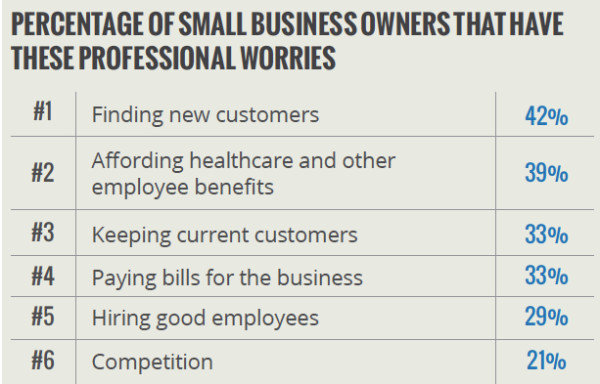8 Tips For Planning Your Small Business’ Marketing Strategy

While the holiday season is undoubtedly a busy period for small business owners, it’s important to set aside time to plan your marketing strategy for the year ahead. How will you continue to maintain and grow your business in 2014? What plans do you have to keep your business on track and stay ahead of […]
While the holiday season is undoubtedly a busy period for small business owners, it’s important to set aside time to plan your marketing strategy for the year ahead. How will you continue to maintain and grow your business in 2014? What plans do you have to keep your business on track and stay ahead of the competition?
Issues related to marketing are top-of-mind for small business owners going into the New Year. In fact, according to Yodle‘s recently released First Annual Small Business Sentiment Survey, 42% of small business owners said they are worried about finding new customers, making it their #1 overall concern. Additionally, 33% of small business owners surveyed said that keeping their current customers is a concern (#3 overall), while 21% of owners cited their competition as something they worry about (#6 overall).

Source: Yodle’s First Annual Small Business Sentiment Survey, Aug. 2013
As we can all attest, 2013 was a year in which consumers increasingly adopted new technology, search and review tools and social media channels to help drive their path to purchase. This was also a year in which a variety of new marketing tools were introduced that make it easier for small businesses to reach and convert consumers in the places where they are increasingly searching.
Yet, despite small business owners’ concerns about effectively marketing their businesses, many are not making the necessary investments to adapt to today’s fast-paced and changing environment. While the consequences of inaction may seem small now, they will only become greater in the future, threatening the stability and growth of small business owners’ operations.
As you plan for 2014, make your New Year’s resolution to review the 8 simple tips below for building a better marketing strategy for your business — one that puts your customers first and your business second-to-none.
1. Develop A Realistic Forward-Looking Marketing Budget
It’s time to put your money where your mouth is. Small business owners today cite customer attraction and retention as two of their most pressing concerns, but many set aside minimal budgets for marketing.
In fact, 1 in 4 small business owners report that they don’t spend any money on marketing, while just over half (56%) spend less than $500 a month. In other words, only about a quarter of business owners spend more than $500 per month on marketing.

Source: Yodle’s First Annual Small Business Sentiment Survey, Aug. 2013
Make this the year that you corner off a larger, more flexible budget to tackle new marketing opportunities to better adapt to today’s fast-changing marketplace. I’m not saying you should break the bank allocating funds to marketing. What I do recommend is that you make strategic investments on marketing offerings that better position your business in places where consumers are increasingly going to research products or services and make purchases.
Return-on-investment should be the key factor by which you measure your marketing efforts. However, be sure to give your business the flexibility to try out new marketing opportunities and ideas to see if they stick.
There’s no doubt in my mind that any business keeping with a status quo of limited marketing in today’s changing environment will only hurt their bottom line — and not just in the short run. Small businesses should be making smart investments so they are well-positioned to attract consumers now and in the future.
2. Build A Simple & Effective Website
The website is the central component of any business’ digital strategy; it’s how your current and potential customers can most easily find and connect with you. Given its key role, it’s astonishing that more than half of small businesses owners (52%) said their business does not have a website, according to the Yodle survey.
Make your website a priority this year. Whether you’re just building your website now or looking to improve the one you have, keep these key things in mind moving forward:
- Make Contact Information Visible & Consistent: Incorporate your business’ contact information (phone number, address, email address, etc.) throughout your site, not just in your About Us or Contact Me section. Ensure that your contact information is consistent with what you have included on online business listing websites.
- Design An Appealing, Easy-To-Use Interface: Invest in a contemporary website with a visually appealing color scheme and straightforward navigation. It will not only make your website more attractive and seamless to navigate, but will also reflect on the professionalism of your business. Be careful about using features such as Flash which may negatively impact your site’s search ranking potential and which don’t load on some smartphones.
- Use Defining & Searchable Keywords On The Front & Backend: In drafting content for your website, be sure to incorporate keywords that consumers will most likely use when searching for your products and services. Ensure that your web designer incorporates these keywords into anchor text in page URL links and adds keyword-specific titles, descriptions and tags to videos posted on your website.
- Keep Current By Regularly Updating Content: In order to stay relevant to those visiting your site (including search engine crawlers) be sure to update your website content on a consistent basis. Develop an editorial calendar to update your site in conjunction with big promotions and sales, events, and other notable activities, or when you introduce new products or services.
- Monitor Website Analytics: Pay close attention to where your website visitors are coming from, how they’re finding you, and what they’re doing while on your website, so you can consistently update and improve their experiences through tweaks to your site’s navigation and content.
3. Ensure Your Website Is Mobile-Optimized
As consumers increasingly turn to smartphones and tablets to search for local business information and to shop products and services, it’s essential that your website is properly optimized for those experiences.
A recent Google/Nielsen study found that 59% of consumers visit a business’ website when conducting a mobile search. However, the vast majority of small business owners — 9 out of 10 — said their websites aren’t optimized for mobile, according to the Yodle survey. This represents a clear gap in small business’ ability to provide on-the-go consumers with a proper website experience, thus threatening their chances for securing business from those visitors.
This is the year to bring your business website into the mobile era. Here’s how to get started:
- Conduct A Mobile Audit: Develop an audit of your current website to determine what types of mobile consumers are visiting your website, and what they’re generally looking for when they’re there.
- Build A Mobile-Specific Website: Taking into account the findings from your audit, create a mobile-specific website that represents a slimmed down version of your desktop website. This mobile site should showcase the key topics that mobile users are generally looking for when they visit your site, so it’s easier to find them. For example, if you run a restaurant, you may consider creating a site that highlights the menu, reservations and contact information – and removes other information available on the desktop site that is less important.
- Ensure Mobile Users Know What They Can Do On The Website: Use call-to-action messaging to make clear what consumers can accomplish via the mobile website. For example, if consumers can schedule appointments or purchase products directly from the mobile site, make that as clear as possible through bold text, buttons and other eye-catching graphics.
4. Build A Complete & Accurate Listings Presence
Whether it’s Google, Bing, Yelp, YP.com, Yellowbook.com or SuperPages.com, small businesses appear on a variety of business listing websites. Ensuring that your business’ listing is complete and accurate plays an important role in determining whether consumers reviewing your listing can move forward with contacting you and making a purchase.
It may be surprising, but a notable share of business listing information is inaccurate. In fact, a ConstantContact survey of more than 350 SMBs earlier this year found that 50% of SMBs have come across inaccurate listings for their businesses. Despite this, nearly half (49%) of those surveyed said they’ve never updated their business listings online.
Spend time in 2014 getting your business’ listings up-to-speed with correct information:
- Check Up On Your Listings: Certify that your business is listed — and accurately — with services like Localeze, Axiom, SinglePlatform, Yext and Universal Business Listing, since they are the primary listings providers for local websites and apps.
- Make Your Listings As Complete As Possible: Take a close look at your business’ listings on each of the major local websites to ensure that your information is accurate. Then build out your business listings on each of these sites with any missing information, such as your website address, social media channel addresses, business photos, menus or offerings and the like. This will ensure that your consumers viewing your listings have as much information as they need to make a decision before contacting you.
5. Successfully Manage Negative Online Reviews
Online reviews are playing an increasingly central role in driving consumers’ purchasing behavior. Similar to word-of-mouth, consumers place high trust in the accuracy of online reviews. In fact, a recent Nielsen online study of 29,000 consumers across 58 countries found that about 70% of consumers trust online reviews – making them the third-most trusted form of advertising. Another recent study from Harvard Business School showed that something as simple as a one-star improvement in a Yelp business listing can deliver a noticeable increase in a restaurant’s revenue.
With the stakes so high, it’s important for small businesses to develop procedures for locating and responding to online reviews. Small business owners should spend time mapping out or improving their response plan for online reviews – especially those that place their business in a negative light.
When developing your online review plan, consider the following:
- Attempt To Prevent Customers From Writing Negative Reviews In The First Place: You should try to stop the problem before it starts by creating an environment where your customers are kept satisfied and that issues are dealt with quickly and professionally. This means ensuring that customers can reach your business directly and that you have policies in place for dealing with common problems related to your offerings.
- Monitor Review Sites On An Ongoing Basis: Set up a regular monitoring schedule for the leading review websites, and a process for who will review and respond to negative reviews.
- Keep Positive & Respond Directly: It’s easy to get upset by a negative review, since often your business has a difference of opinion with the customer over what took place. That said, ensure that your core response messages are professional and focus on ways to remedy the problem. As a first step, always try to contact the negative reviewer directly to see if you can remedy the problem.
- Determine When To Respond Publicly: Set a policy for what red lines must be crossed in order for you to respond to a negative review publicly. Perhaps your first course of action is to ask the customer to take down their negative review. If they don’t, then perhaps the next step is to respond to the review publicly by noting exactly what your business did to address the problem. The course you take depends on the nature of the review and your business’ personality, but having set guidelines in place will help you to remain consistent.
- Encourage Happy Customers To Leave Positive Reviews: Setup a strategy for encouraging satisfied customers to post positive reviews on the sites most important to you. This can be as simple as sending the customer an email after the transaction that asks them to leave feedback on a specific review website.
6. Build An Engaging Social Media Presence
Consumers today spend a considerable amount of time on social media interacting not only with family and friends, but increasingly with brands as well. Businesses in a variety of categories — ranging from retailers to restaurants — are successfully building social media channels to generate loyalty and engagement with their customers and potential customers. In fact, Facebook recently announced that 24 million small businesses maintain active pages on their site.
In developing or improving your social media for 2014, take the following into account:
- Determine Which Social Media Channels Work Best For Your Business: Facebook and Twitter provide strong platforms to reach the vast majority of consumers with business updates, sales and promotions, new products and services and the like. They also offer the ability to engage in one-on-one conversations with consumers regarding questions, concerns and complaints. Specialized social media sites also provide their own benefits. Pinterest, for example, enables businesses to share visually appealing offerings like clothing, furniture, art and landscaping with a like-minded audience. And sites like YouTube enable small businesses such as a DJ to post videos of their latest parties, or a local bakery to share how they make their favorite bread. As a starting point, spend some time mapping out which channels you want to use for your business and why.
- Develop An Editorial Calendar To Remain Engaged: If you create a page for your business on a social media network, it’s imperative that you remain engaged and not let the page sit idle. Consumers today expect businesses to update their social media channels several times a week with relevant information. In order to keep a steady flow of updates, develop an editorial calendar in advance so you can map out content and coordinate your efforts. Incorporate compelling photos, videos and other visual content and provide incentives to those following your pages to stay connected.
- Respond Promptly To Consumer Questions: Consumers view your social media channels as an extension of your digital presence and expect you to respond to questions, comments and other inquiries they share there. So setting up a process for monitoring your business’ pages is key.
- Share Your Deeds!: Once your channels are established, share your information wherever you can: through posters and flyers, advertisements, your business’ website, etc. Explain to customers why it’s worth it for them to follow you.
7. Take Advantage Of Automated Scheduling & E-Commerce Tools
In 2013, we saw a lot of strong activity on the automated scheduling and e-commerce front. Yet despite the promise of these new offerings, many small businesses have remained on the sidelines. For example, only 39% of small business owners rely on automated appointment booking and scheduling technology, according to the Yodle survey.
In 2014, take the opportunity to reevaluate the benefits of these new tools:
- Popular local websites such as Yelp, along with local vertical websites such as OpenTable, Seamless and GrubHub introduced new offerings that make it easier for consumers to seamlessly purchase products or schedule appointments at businesses from wherever they are. And these offerings are expanding beyond just restaurants to also include everything from doctor appointments to home repairs services.
- Sites like Amazon, eBay and Etsy continued to improve their offerings for digital storefronts that enable consumers to easily shop and purchase from businesses via their desktop, smartphone or tablet.
While there are fees are associated with each of these e-commerce offerings, small businesses benefit from avoiding start-up and maintenance costs to build these systems on their own. The tools also increase efficiency (cutting down on labor costs) and provide great platforms for increased visibility in online search.
8. Use Results Reporting To Inform Your Strategy
The Yodle survey found that more than half (56%) of small business owners do not measure results from their marketing. This means that those small business owners have no baseline to determine how well their marketing is doing or how to set priorities for what else they can or should be doing.

Source: Yodle’s First Annual Small Business Sentiment Survey, Aug. 2013
As you head into 2014, develop a simple reporting structure — perhaps a monthly report that you dedicate yourself to doing — that will enable you to clearly see how all of your marketing activities are doing and their resulting impact on your business.
It’s my hope that once you see the benefits of your business’ marketing dollars at work, you will begin to feel differently than the majority of small business owners by being excited — and not worried — about your ability to retain and attract customers in the future.



